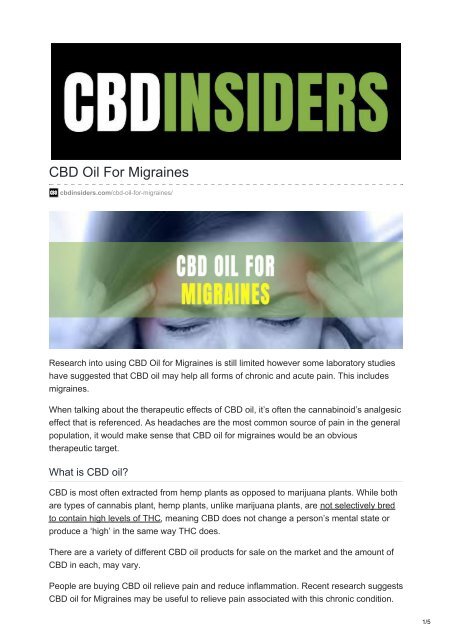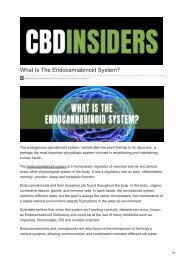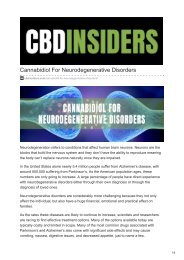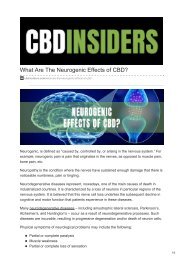CBD Oil For Migraines
Research into using CBD Oil for Migraines is still limited however some laboratory studies have suggested that CBD oil may help all forms of chronic and acute pain. This includes migraines. When talking about the therapeutic effects of CBD oil, it’s often the cannabinoid’s analgesic effect that is referenced. As headaches are the most common source of pain in the general population, it would make sense that CBD oil for migraines would be an obvious therapeutic target.
Research into using CBD Oil for Migraines is still limited however some laboratory studies have suggested that CBD oil may help all forms of chronic and acute pain. This includes migraines.
When talking about the therapeutic effects of CBD oil, it’s often the cannabinoid’s analgesic effect that is referenced. As headaches are the most common source of pain in the general population, it would make sense that CBD oil for migraines would be an obvious therapeutic target.
Create successful ePaper yourself
Turn your PDF publications into a flip-book with our unique Google optimized e-Paper software.
<strong>CBD</strong> <strong>Oil</strong> <strong>For</strong> <strong>Migraines</strong><br />
cbdinsiders.com/cbd-oil-for-migraines/<br />
Research into using <strong>CBD</strong> <strong>Oil</strong> for <strong>Migraines</strong> is still limited however some laboratory studies<br />
have suggested that <strong>CBD</strong> oil may help all forms of chronic and acute pain. This includes<br />
migraines.<br />
When talking about the therapeutic effects of <strong>CBD</strong> oil, it’s often the cannabinoid’s analgesic<br />
effect that is referenced. As headaches are the most common source of pain in the general<br />
population, it would make sense that <strong>CBD</strong> oil for migraines would be an obvious<br />
therapeutic target.<br />
What is <strong>CBD</strong> oil?<br />
<strong>CBD</strong> is most often extracted from hemp plants as opposed to marijuana plants. While both<br />
are types of cannabis plant, hemp plants, unlike marijuana plants, are not selectively bred<br />
to contain high levels of THC, meaning <strong>CBD</strong> does not change a person’s mental state or<br />
produce a ‘high’ in the same way THC does.<br />
There are a variety of different <strong>CBD</strong> oil products for sale on the market and the amount of<br />
<strong>CBD</strong> in each, may vary.<br />
People are buying <strong>CBD</strong> oil relieve pain and reduce inflammation. Recent research suggests<br />
<strong>CBD</strong> oil for <strong>Migraines</strong> may be useful to relieve pain associated with this chronic condition.<br />
1/5
What is a Migraine?<br />
Migraine pain is categorized as an intense pain that throbs or pulses in a specific spot on<br />
the head and goes beyond the typical stress- or allergy-related headache. <strong>Migraines</strong> last<br />
anywhere from 4 to 72 hours, and even the most mundane activities can amplify your<br />
symptoms. This includes being around noise and light, and moving.<br />
According to the National Institute of Neurological Disorders and Stroke (NIH), migraines<br />
affect 10 percent of the global population and are three times more common in women than<br />
men. Migraine may occur recurrently over many years or even decades. Frequency may<br />
vary greatly in the same person over time, from a few a year up to several a week.<br />
Roughly one-third of affected individuals can predict the onset of a migraine because it is<br />
preceded by an “aura,” visual disturbances that appear as flashing lights, zig-zag lines or a<br />
temporary loss of vision. Evidence shows an increased sensitivity after each successive<br />
attack, eventually leading to chronic daily migraine in some individuals.<br />
The International Headache Society diagnoses a migraine by its pain and number of<br />
attacks (at least 5, lasting 4-72 hours if untreated), and additional symptoms including<br />
nausea and/or vomiting, or sensitivity to both light and sound.<br />
Other symptoms that may be experienced include:<br />
Difficulty in concentrating, confusion<br />
Osmophobia (sensitivity to smell)<br />
A feeling of being generally extremely unwell<br />
Stiffness of the neck and shoulders<br />
Aura (visual disturbances such as bright zigzag lines, flashing lights, difficulty in<br />
focusing or blind spots lasting 20-45 minutes)<br />
Problems with articulation or co-ordination<br />
Paralysis or loss of consciousness (rare).<br />
Tingling, pins and needles or numbness or even one-sided limb weakness<br />
Speech disturbance<br />
Diarrhea<br />
Onset of migraine is from childhood onwards but most commonly in the 20s and 30s and<br />
relatively infrequently after the age of 40; therefore, prevalence increases from the first to<br />
fourth decades and declines thereafter.<br />
A significant number of migraineurs experience warning symptoms for up to 24 hours<br />
before the attacks start but may not recognize these signs until they know what to look for.<br />
Apart from common migraine and migraine with aura, other types of migraine include:<br />
Lower-half Headache or Facial Migraine<br />
Migraine Aura without Headache<br />
Status Migrainosus<br />
Abdominal Migraine (recurrent stomach pains in childhood)<br />
Basilar Artery Migraine (with loss of balance and fainting)<br />
Hemiplegic Migraine (with weakness on one side of the body)<br />
2/5
Ophthalmoplegic Migraine (with double vision)<br />
Retinal Migraine (with loss of vision in one eye)<br />
Migrainous Infarction<br />
Much can be done about migraine. Treatment is not just a matter of taking a tablet but a<br />
case of each individual developing a migraine management plan that will probably involve<br />
lifestyle modifications, medication and complementary therapies.<br />
While pain killers can help alleviate migraine symptoms temporarily, you may be concerned<br />
about their side effects. This is where <strong>CBD</strong> (cannabidiol) oil may come in.<br />
Our bodies’ own natural endocannabinoid system (ECS) plays a crucial role in who suffers<br />
from migraines.<br />
The Endocannabinoid System (ECS) is a modulatory system in the body. Though many of<br />
you have may not heard of such a system existing in the body – the endocannabinoid<br />
system is confirmed to be present within all of us and its very existence is proving valuable<br />
as a medicine for disease, pain and in the maintenance of homoeostasis.<br />
As our largest regulatory system, the ECS can control everything from pain to appetite. The<br />
body produces its own cannabinoids and also has cannabinoid receptors (CB1 and CB2<br />
receptors) in nearly every cell in the body. Though the relationship between these cells and<br />
receptors isn’t fully understood, their interaction is thought to affect the immune system.<br />
As an example, <strong>CBD</strong> may prevent the body from metabolizing anandamide. This is a<br />
compound associated with pain regulation. Maintaining high levels of anandamides in your<br />
bloodstream may reduce your feelings of pain. Anandamide, sometimes known as the bliss<br />
molecule, is the body’s natural version of THC and a 2007 study found that regular<br />
migraine sufferers had below average levels of anandamide. This has led some<br />
researchers to believe migraines are caused by an endocannabinoid system deficiency.<br />
Another study from Colorado in 2016 found that regular cannabis use decreased the<br />
frequency of migraines from 10.4 headaches each month to only 4.6. Furthermore, 11.6<br />
percent of participants reported regular cannabis use stopped their migraines completely.<br />
This is where <strong>CBD</strong> for migraines comes in. Because migraines might be caused by an ECS<br />
deficiency many people are turning to <strong>CBD</strong> oil for migraines, supplementing their ECS with<br />
a daily dose of <strong>CBD</strong> oil as a preventative measure to keep migraines at bay.<br />
<strong>CBD</strong> oil for migraines is gaining popularity as an effective way to treat and prevent the<br />
debilitating headaches. If you suffer from migraines and are wondering how to stop the pain<br />
a daily dose of <strong>CBD</strong> for migraines may help to reduce intensity and frequency of<br />
symptoms.<br />
References:<br />
The Use of Cannabis for Headache Disorders<br />
Effects of Medical Marijuana on Migraine Headache Frequency in an Adult<br />
Population<br />
The endocannabinoid system and migraine<br />
3/5
Variations in the cannabinoid receptor 1 gene predispose to migraine<br />
Endocannabinoids in chronic migraine: CSF findings suggest a system failure<br />
Clinical Endocannabinoid Deficiency Reconsidered: Current Research Supports<br />
the Theory in Migraine, Fibromyalgia, Irritable Bowel, and Other Treatment-<br />
Resistant Syndromes<br />
Cannabinoids suppress inflammatory and neuropathic pain by targeting α3<br />
glycine receptors<br />
The Analgesic Potential of Cannabinoids<br />
Tags AnalgesicCannabidiolCannabinoid <strong>Oil</strong>CannabinoidsCannabisCannabis <strong>Oil</strong>Cannabis<br />
PlantCB1CB2<strong>CBD</strong><strong>CBD</strong> Extract<strong>CBD</strong> <strong>Oil</strong><strong>CBD</strong> SupplementHempHemp <strong>Oil</strong>MigrainePainPain<br />
ReliefTherapeutic<br />
Related posts<br />
<strong>CBD</strong> <strong>Oil</strong> <strong>For</strong> Fibromyalgia<br />
4/5
<strong>CBD</strong> <strong>Oil</strong> <strong>For</strong> Arthritis<br />
<strong>CBD</strong> <strong>Oil</strong> <strong>For</strong> Autism<br />
5/5

















